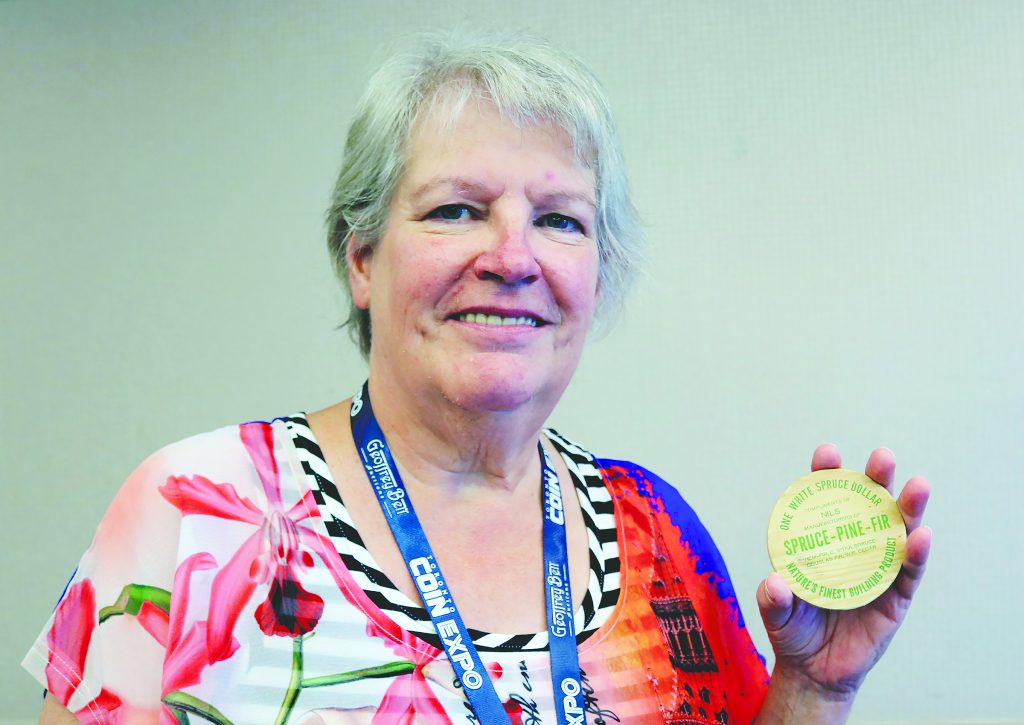By Jesse Robitaille
Founded in 1975 with 45 charter members and expanding beyond 200 members by the end of that decade, the Canadian Association of Wooden Money Collectors (CAWMC) is showing no signs of slowing down.
Throughout more than four decades, the national organization for collectors of Canadian wooden money, tokens and other souvenirs has kept its membership at about 100. A core group of about a dozen members, including President France Waychison, attended the CAWMC’s most recent meeting in Mississauga.
“My goal this past year has been to continue to increase the visibility of the CAWMC,” said Waychison, who has served as the association’s president since 2015. “This year, we put together a package of the constitution, bylaws and policies that should represent CAWMC for many years to come.”
An active collector of wooden money for more than a decade, Waychison has also been the editor of the society’s monthly publication, Timber Talk, since this November, when she replaced Judy Blackman.
“We like to see most of our members submitting at least one article, and I’ve been pestering some members to write stories about the woods they issue.”
Secretary-Treasurer Al Munro, who previously served as CAWMC president from 2005-15, thanked Blackman “for all her service” to the association.
“She’s kept the organization going, and without our Timber Talk, we really don’t have an organization.”
TREASURER’S REPORT
In 2017, the CAWMC lost “a substantial amount of money” due to the production of a promotional wood as well as a Canada 150 medal, Munro said.
“For the promotional woods, we lost about $400, and for the Canada 150 medals, including the cost of the dies, we lost $810. It was approved ahead of time when we decided we wanted to share this immense event,” said Munro, who’s also the club’s membership chair.
“We also spent a few dollars obtaining members’ woods for distribution.”
The association’s membership has “gained a little bit,” said Munro, who added one former member returned after four years, paying each year’s dues in exchange for each issue of Timber Talk he missed.
“We’re in a good financial position, and I don’t see any major expenditures coming in the future that would erode this.”
WOODEN MONEY HISTORY
The long-standing tradition of “wooden nickels,” something that dates back nearly a century, has since grown to include other materials, including plastic. But wood – especially maple, red alder, birch, beech and finely sanded ash – still reigns supreme.
With a variety of inks and colours, “woods” can be blank, heat pressed, screen printed, laser printed, etched, hand-carved, hand-painted, varnished or embroidered with a natural wood finish, varnish or double-veneer. They come in a variety of sizes, the most common of which is 38 millimetres, and can be flat, stubby, round or square and everything in between.
It’s believed the first use of wooden money was in the town of Tenino, Wash., where a local bank failed on Dec. 4, 1931, amid the Great Depression. The community issued emergency currency printed on thin wood to allow residents to make purchases, and the local government used wooden tokens for the state’s sales tax system.
In 1933, wooden currency was also issued in nearby Blaine, Wash., in denominations of five, 10, 25 and 50 cents as well as $1.
“It was backed by non-interest-bearing warrants and merchants’ notes,” according to Nancy and John Wilson’s 1988 article, “Blaine, Washington Emergency Money and the Great Depression.”
“The warrants were issued as security for money, for redemption of wooden money only, and were redeemable in United States currency or gold.”
The first souvenir wooden money was produced for the Chicago World’s Fair in 1933, after which several communities became interested in the idea and issued their own souvenir tokens made of wood.
In Canada, wooden money appeared by the late 1950s, according to Chapter 12 of the Royal Canadian Numismatic Association’s Canadian Numismatic Correspondence Course – Part II. The first examples were thick and stubby pieces known as “broomsticks,” which looked like they were cut from a broom handle. Typically measuring 25 mm in diameter, these woods had their designs pressed into the top and bottom; however, most examples were varnished and the design was difficult to see.
In the early 1980s, larger and thinner woods were stamped using a hot press, and later, the silk screen-printing method was used.
Today, laser printed woods are popular for their intricate and crisp designs.
One of the most iconic Canadian wooden money pieces is the spruce dollar of Prince George, B.C., which has about 150 different issues measuring about 86 mm in diameter.
It’s one of many; in fact, there are more than 8,500 different pieces listed in catalogues such as the Canadian Woods Catalogue maintained by Norm Belsten, who’s one of 45 original charter members of the CAWMC.
New discoveries of old woods happen all the time, he said.
“Two years ago, I put out a picture catalogue of approximately 750 pages of coloured woods,” said Belsten, who added he’s continuously updating the catalogue. “It goes back to day one, and I’ve been cataloguing for 30 years.”
He was selling copies of a recent update at the RCNA Convention this August, when the group last met.
“I got five pages of woods emailed to me about a week before the convention, and I’ll probably try to do another update sometime next year.”

